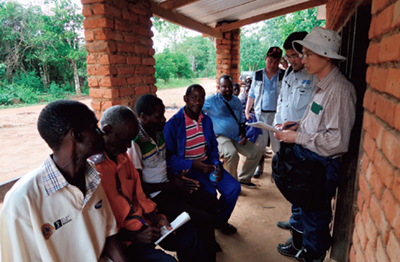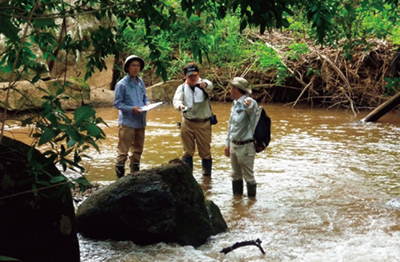Master Techniques from Japan to the World 5
Hybrid Hydro and Photovoltaic Power Systems for Unpowered Rural Villages
– Contributing to the Improvement of the Lives of the Malawians through Electricity
Malawi, a landlocked country of 18 million people (according to a 2016 World Bank survey), is one of the poorest countries in Africa located in the south east of the continent. The reach of electrical infrastructure in the rural areas of the country, where roughly 80% of the population reside, is less than 1%, and rural villages do not even have access to satisfactory lighting at night.
While the Malawian government is working towards rural electrification and the use of hydroelectric power generation as one of the pillars of national policy, with the country's difficult financial situation, there is no perspective of extending electrical transmission infrastructure to the unpowered rural villages, which requires a large amounts of costs. Furthermore, while the development of small-scale power generation using renewable energy sources is being promoted, such as micro-hydroelectric* plants leveraging the abundant water resources in the hilly and mountainous areas, sustained action to electrify rural villages has not yet been achieved. This is because not only are financial resources inadequate, but technical and system design standards are low while experience in operating small-scale power plants and in the business of selling electricity is limited.
Taking an interest in the situation surrounding the electrification of rural villages in Malawi, Nikken Corporation, a company with headquarters in Minami-Alps City, Yamanashi Pref., submitted a proposal to the Feasibility Survey for Introducing Japanese Technology under JICA's Support for Japanese Small and Medium-sized Enterprises (SMEs) Overseas Business Development in March 2016, which was selected the following July. For one year beginning in December of the same year, the survey was carried out to test the applicability of their proposed Micro hydro-solar hybrid power system with battery with rural villages in Malawi, as well as operational feasibility, potential issues, and the electrification needs of those villages.

Interviewing local residents in an unpowered rural village(Photo: Nikken Corporation)
The company staff members visited 10 unpowered villages (of approximately 100 households each) located throughout the mountainous region of Nkhata Bay, 340 km north of the capital city Lilongwe, in order to survey water streams and the surrounding environment of the candidate sites of the system installation, as well as needs of local people. The survey found that these rural villages were already using automobile and motorcycle batteries to power lighting, charge cellphones, and operate radios. However, it was also found that the villages did not have any facilities to charge those batteries, and had to take a day-long trip to the city to use the charging facilities there.

Members of Nikken Corporation searching for possible micro-hydroelectric sites (Mr. Amemiya is on the far right) (Photo: Nikken Corporation)
As a result of the survey, company President Makoto Amemiya recalls, “We were able to confirm that our hypothesis that the installation of charging stations in village centers would provide villagers with access to electricity and raise the living standard and educational environment in the villages.”
Plans for a power generation and charging service using the charging stations are operated by a village electrification committee comprised of members from the Malawi Energy Regulatory Authority, the regional developmental organization for Nkhata Bay, and local residents. It is premised on the charging service to require a fee, rather than being free of charge. The reason is that it would be essential for the electrification committees to manage charging fees and to apply them to future system maintenance in order to establish a fund management model.
There is another important theme for the project to install the systems, in addition to powering electrical lighting. Mr. Amemiya explains, “We hope to promote the development of richer community building using electrification as a stepping stone. It is important that village electrification also change the awareness of the villagers.” Mr. Amemiya continues, “Because the people living in this region do not have adequate access to electricity, their access to information via cellphones and radios is strictly limited. However, if they gain access to real time data on a regular basis, it will serve as an important factor in directly raising the living standard, such as by enabling them to research the correct wholesale price for their crops. Our aim is for them to take the initiative in thinking about how to change their lives using the electricity.”
Mr. Amemiya passionately explains that subsequent developments are even more important. “I want the people of Malawi themselves to take the initiative in spreading the wave of electrification over unpowered regions. I want the smiles of satisfaction from the electrification of the Malawian people who have the “warm heart of Africa” to spread all throughout the country. We hope to play the role of the trigger for this by providing the required technology and business model.”
Mr. Amemiya has high expectations that if a foothold for spreading Japanese high-quality products and after-sales service over the countries of southern Africa including Malawi can be achieved, it would provide momentum for Japanese SMEs attempting to expand their business to the African continent.
* The majority of micro-hydroelectric power plants notably do not require large structures such as dams, but rather generate electricity by spinning water wheels using the natural flow of rivers.
<< Previous Page Next Page >>
Main Text | Statistics and Reference Materials | Stories from the Field | Master Techniques from Japan to the World | ODA Topics
